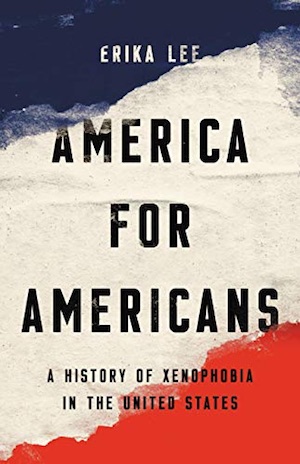By Fred H. Lawson
Xenophobia—the fear and hatred of foreigners—enjoys a long history in the United States of America. Eighteenth-century residents of Philadelphia distrusted and mistreated newly arrived migrants from the German principalities. During the 1850s, the citizens of Louisville and Cincinnati vented their disgust toward recent arrivals from Ireland. Two decades later a popular movement arose in San Francisco against people who had come to California from China. At the turn of the twentieth century, Italians, Russians, Hungarians, Bohemians, Croats and other southern and eastern Europeans found themselves targeted by influential elites in Boston, New York, and Detroit. America for Americans recounts these successive episodes in vivid detail, along with more recent eruptions of overt hostility toward Mexicans, Japanese, and Middle Eastern Muslims.
Erika Lee makes two strong claims regarding American xenophobia: that it is a “constant” feature of the country’s history and that it is intimately associated with race. The first assertion rests uneasily with the underlying structure of the book. Each chapter describes a particular episode of anti-foreignism, and although there are intimations that earlier instances of animosity set the stage for later ones, just how they are interconnected remains largely unaddressed. Do seemingly separate manifestations of xenophobia display parallel patterns or trajectories?
More important, what happens during the interval between outbreaks of virulence? Lee remarks that in the wake of the anti-Chinese outburst of the 1870s, “xenophobes became increasingly alarmed about new immigration from Asia, particularly from Japan, Korea, South Asia, and the Philippines—all condemned as more ‘Oriental invasions.'” Yet she does not take the opportunity to tell those stories, and thereby bridge the gap between the anti-Chinese wave and the anti-southern and eastern European wave of the 1890s. Xenophobia appears to be less a constant than a recurrent phenomenon, which takes somewhat different forms each time it appears.
Equating xenophobia with race hatred creates equally substantial difficulties. Lee observes that “Some [eighteenth-century Americans] even viewed [Germans] as ‘constitutionally’ (i.e., physically and biologically) alien to the English.” Yet it requires a good deal of conceptual stretching to consider this a sign of inter-racial antagonism. There is a sizable body of scholarship that explicates the racialization and deracination of the Irish, but anti-Mexicanism poses problems much like those of anti-Germanism. Lee says that “Anti-Mexican racism that classified Mexicans as an inferior and hybrid (Spanish, indigenous, and black) race had long been part of US imperialism and expansion into the Southwest,” but then points out that “they were also legally white.” Consequently, the Mexican community ended up getting construed instead as morally corrupt and “illegal.”
Race clearly provides the impetus for much of the xenophobia that flourishes in the United States. America for Americans shows that a surprising amount of anti-foreignism has also been propelled by religion. Newcomers from Ireland, Italy, Mexico, and the Islamic world have been despised and rejected as much for their spiritual beliefs and practices as for the color of their skin. Exactly which component of White, Anglo-Saxon Protestantism bears primary responsibility for the public’s widespread fear and hatred of outsiders merits further exploration.
Social scientists will be uncomfortable with the book’s persistent conflation of fear of foreigners with a wide range of other things, including nativism, the insistence that new United States citizens fully assimilate into English-speaking culture, the notion that there exists a hierarchy of races and public policies that discriminate on the basis of race. These disparate phenomena may well be bound together in fact, but it becomes almost impossible to understand the ways in which they interact—and occasionally work at cross-purposes to one another—if they are not kept analytically distinct.
After January 2017, American xenophobia seems to have reflected a fear of indiscriminate physical violence, or “terrorism,” more than anything else. Earlier studies of United States foreign policy have argued that much of the outrage that drives spasms of military engagement with the outside world derives from threats of attack by foreign forces. The case of the Japanese community during the 1940s demonstrates that this dynamic long predates September 2001. One wonders how much of the anti-Italian and anti-Russian sentiment of the 1890s might have been prompted by the anarchist and revolutionary movements that swept across the globe at the moment the United States was emerging as an international actor.
Fred H. Lawson (ΦBK, Indiana University) is Professor of Government Emeritus of Mills College, and sometime Visiting Fellow of St. Antony’s College, Oxford.




